Dogs for sale
Pet Supplies
How to draw a dog
Join Our Dog Forum FREE!
Trendy Dog Clothes
Dog Supplies
Dog Forum
Dog Health
Dog Articles
Dog Posters
2010 Dog Calendars
Dog Cages
Portable Dog Crates
Electronic Dog Doors
Dog Kennels
Small Dog Clothes
Slow Cooker Recipes
Dog Leads
Pet Travel Guide
Toy Dogs Guide
Dog Supplements
Dog Medicine info
Dog Allergies
Dog Portraits
Dog Resources
Sitemap

Mastiff Breed Information
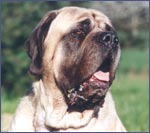
Lordly Mastiff - Text Anne Marie Class, pictures Anne Marie Class and RR
The former general dogsbody in the UK, the Mastiff is a heavy weight, as bitches weigh from 65 to 80 kilos and dogs from 85 to 100 kilos. Simply impossible to go unnoticed.
| From guard dog to village dog, or war dog, from fight dog to large game hunting dog, the Mastiff has proved his versatility all along his history. The role he played the more was that of guard dog, it was the village or the castle’s dog. People especially counted on its dissuasive strength. To quote Raymond Triquet, “A Molossian is the kind of dog you show, so as not to have to use it.” It’s still very hard today to find its true origins, but what is sure is that the breed was then not as uniform as it is now. Its look was adapted to the way it was used. |
A bit of history
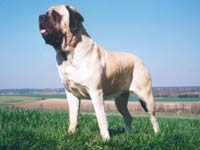 A
Mastiff bitch became famous at the battle of Agincourt by defending the
body of her master, sir Piers Leigh; this was the origin of the renown
Lyme Hall line, which was preserved through the centuries with great fondness.
The trusty and courageous bitch had mated in France with a dog of her
kind, before going back to her native country. In one of his plays, Shakespeare
has a Frenchman speak as follows on the dogs at Agincourt: “They have
very brave creatures in England, their Mastiffs have a courage beyond
compare.” The ambassador of the English King Edward 4, relates that
he was greeted by Louis 11 and his 5 Mastiffs, and that the French King
later received many other dogs from Great Britain. A
Mastiff bitch became famous at the battle of Agincourt by defending the
body of her master, sir Piers Leigh; this was the origin of the renown
Lyme Hall line, which was preserved through the centuries with great fondness.
The trusty and courageous bitch had mated in France with a dog of her
kind, before going back to her native country. In one of his plays, Shakespeare
has a Frenchman speak as follows on the dogs at Agincourt: “They have
very brave creatures in England, their Mastiffs have a courage beyond
compare.” The ambassador of the English King Edward 4, relates that
he was greeted by Louis 11 and his 5 Mastiffs, and that the French King
later received many other dogs from Great Britain. |
| The Mastiff has had his hours of glory, and it also had his downs, like
at the end of the 19th century, in Great Britain, were only
25 births were registered in 1900. Likewise, for obvious reasons, the
Mastiff had almost disappeared from its native country at the end of WWII.
Fortunately, the situation was not the same in the USA. Thanks to a few
imports mated with a few native survivors, some fanciers managed in reconstituting
the breed in Great Britain. The Old English mastiff Club was created in 1883, and it still exists nowadays. But the first club had been founded in the USA four years before. The Mastiff Club of America, officially recognised by the American Kennel Club, has been working since 1929. |
A touch of Dogue de Bordeaux
 For the little story, you should know there’s some Dogue de Bordeaux’s
blood in the Mastiffs. A Dogue de Bordeaux bitch, Fidelle de Fénélon,
imported to the USA in 1959, was accidentally registered as a Mastiff
by the American Kennel Club. She later was mated with a real mastiff,
Merles Alvin. Grand grandchildren of this bitch became Best of Breed in
Specialty Shows, and one of her descendants, called The Devil Of Wayside,
was imported to Great Britain, where he became champion himself and was
father to many champions.
For the little story, you should know there’s some Dogue de Bordeaux’s
blood in the Mastiffs. A Dogue de Bordeaux bitch, Fidelle de Fénélon,
imported to the USA in 1959, was accidentally registered as a Mastiff
by the American Kennel Club. She later was mated with a real mastiff,
Merles Alvin. Grand grandchildren of this bitch became Best of Breed in
Specialty Shows, and one of her descendants, called The Devil Of Wayside,
was imported to Great Britain, where he became champion himself and was
father to many champions. |
 This
recent contribution of a new bloodline line was an involuntary act, yet
new contributions have always existed in the Mastiffs and in almost all
the other breeds, in order to select the proper dogs for the proper purposes. This
recent contribution of a new bloodline line was an involuntary act, yet
new contributions have always existed in the Mastiffs and in almost all
the other breeds, in order to select the proper dogs for the proper purposes.
We know that Mastiffs had been exhibited in France at the beginning of the 19th century, yet one had to wait until the early 1970’s to see the breed enter the French Official Stud Book. To finish with this survey of Mastiff history, and while risking to displease those loving extreme sizes, let’s note that Mastiffs are larger now than they previously were. |
I’m sticking with you
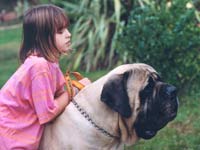 The word “Mastiff” comes from the Old French “mastin”, which came from
the Latin “mansuetus”, meaning tame. And it’s easier to see kindness than
fierceness in the Mastiff.
The word “Mastiff” comes from the Old French “mastin”, which came from
the Latin “mansuetus”, meaning tame. And it’s easier to see kindness than
fierceness in the Mastiff.The Mastiff is a monument of tenderness, and that’s one thing you should know, as he can show his affection in somewhat exuberant and overwhelming ways. It’s a Lord, and will therefore act so, waiting to be served, letting himself go when he’s ill. Fortunately, this rarely happens. But he’ll pay you back one hundred times what you’ve given him. |
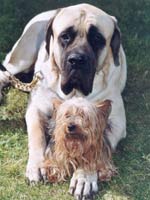 This
is an easy going down, and as long as he’s near his owner, he feels happy.
His ideal is “a house and a heart”. Although it is very affectionate with
his family, it’s an excellent guard dog, and will be naturally very protective
of them. If he stands at the door or at the garden gate, you’re sure no
one will insist to break in. This dog likes to frighten people, but it
hasn’t a single ounce of wickedness in him. It’s the typical nice guy.
It is first wary of strangers, but once he has been introduced, he’s very
friendly. It is quite an obeying dog, but it will seldom act hastily.
The Mastiff will generally get along pretty well with the other dogs,
and other animals as well. A few years ago, a Mastiff breeder also bred
Chihuahuas, and she never missed an opportunity to show David and Goliath
side by side in exhibitions. This
is an easy going down, and as long as he’s near his owner, he feels happy.
His ideal is “a house and a heart”. Although it is very affectionate with
his family, it’s an excellent guard dog, and will be naturally very protective
of them. If he stands at the door or at the garden gate, you’re sure no
one will insist to break in. This dog likes to frighten people, but it
hasn’t a single ounce of wickedness in him. It’s the typical nice guy.
It is first wary of strangers, but once he has been introduced, he’s very
friendly. It is quite an obeying dog, but it will seldom act hastily.
The Mastiff will generally get along pretty well with the other dogs,
and other animals as well. A few years ago, a Mastiff breeder also bred
Chihuahuas, and she never missed an opportunity to show David and Goliath
side by side in exhibitions. |
 The Mastiff is no great sporting dog, and you’d better not count on him
to exercise alone. He prefers to stay where his owner is. But if his owner
is sportive, it will gladly follow him for long walks. You can take advantage
of his fondness for games to practice agility, or even tracking, as it
has a good sense of smell. It has a lively nature, it just loves to play
with balls, or anything for that matter. It also loves to bathe, play
with water, and swim. Many Mastiffs like the rain, so be careful when
they come back home and shake themselves.
The Mastiff is no great sporting dog, and you’d better not count on him
to exercise alone. He prefers to stay where his owner is. But if his owner
is sportive, it will gladly follow him for long walks. You can take advantage
of his fondness for games to practice agility, or even tracking, as it
has a good sense of smell. It has a lively nature, it just loves to play
with balls, or anything for that matter. It also loves to bathe, play
with water, and swim. Many Mastiffs like the rain, so be careful when
they come back home and shake themselves. To sum up, the Mastiff is a tough looking dog with a heart of gold; he is a simple companion, he has tons of affection for those he loves, and a natural skill for guarding. |
The Mastiff’s health
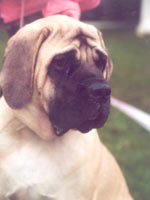
Just like any other large breeds, the Mastiffs require specific care. The aim of breeding Mastiffs is not to produce mastodons, but healthy dogs with substance. Generally speaking, this is not a weak dog, on the contrary; he’s rather rustic, and he doesn’t fear cold thanks to his good undercoat. The most critical period is that of growth. The worst thing for a young growing puppy, is to be with another younger and livelier puppy, as those large puppies need to have long periods of rest during the day. There’s also another important thing: one should avoid, as it is sometimes done, to provide them with extra vitamins or calcium, without the advice of a veterinarian. |
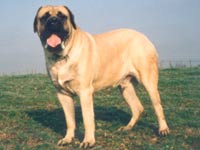
The dog should also make enough sport to remain healthy, and keep his musculature. And walking is good for both the owners and the animal. For a Molossian, Mastiffs tend to have good hips. In France, for instance, 70% are tested A or B, and there’s only a very small number of D or worst. An eye examination is also performed on the dogs. This is a common practice in the USA, and the Mastiff Club of America advises the breeders to test the eyes, hips and elbow of their dogs. A serious American breeder will never get angry if you ask him or her to see the dogs papers. Mastiffs, like other large breeds, don’t live very old, but you can probably expect to spend 10 years with your companion. Some Mastiffs sometimes reach the age of 13. |
Training your Mastiff
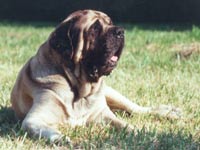 Considering
the weight and size of the dog, it is useless to say that he should know
who’s the boss at home. Anyway, this will be rather easy to make him understand.
You should teach him good manners at an early age, get him used to seeing
other people by taking him in the streets, to be patient with children,
and to get along well with other animals. Considering
the weight and size of the dog, it is useless to say that he should know
who’s the boss at home. Anyway, this will be rather easy to make him understand.
You should teach him good manners at an early age, get him used to seeing
other people by taking him in the streets, to be patient with children,
and to get along well with other animals. But truly enough, this works with all the dogs. |
Back to English Mastiff information